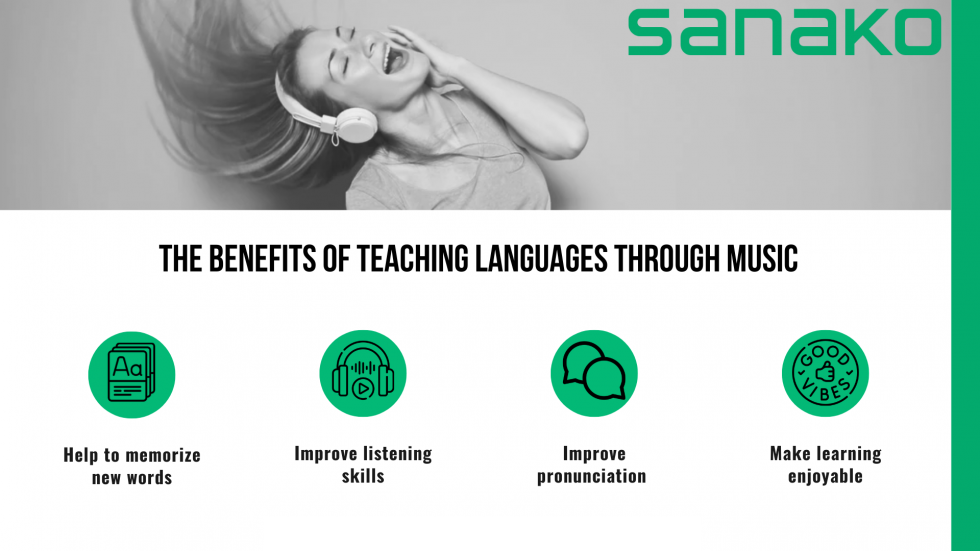Music and language are the faculties that distinguish human beings and share a close relationship on a cognitive level. In fact, several studies have investigated the relationship between language skills and musical faculties. For example, according to an experiment conducted in Finland:
As a result, in cognitive sciences there is a growing consensus about the existence of a relationship between the ways in which the brain processes language and music systems.

For those who teach and study foreign languages, the fact that there is a correlation between music aptitude and linguistic sensitivity is significant. This means that listening to and practising music can have an impact on language-related abilities!
At Sanako we are always looking for solutions and new ideas that can help language teachers enrich their teaching techniques. In a previous article we examined how to improve teaching through the language lesson’s gamification process. In this blog article instead we want to introduce a bit more uncommon language teaching methodology and offer you tips to fire up your language teaching with some music!
Rocking your language classroom using music
Musical elements, such as rhythm, verse, pitch, are part of the same toolkit that we use when we learn a language – be it our mother tongue or a foreign language.
Integrating music into language lessons is advantageous for both the teacher and the students.
From a methodological point of view, making music an integral part of your language teaching method helps to stimulate cognitive processes that are already present in the students’ minds.
From a didactical point of view, on the other hand, melodies and lyrics helps to differentiate the content of the lessons and to create a positive environment capable of stimulating the concrete and creative use of the language by the students.
When listening to songs, students are encouraged to set in motion different language-related abilities. Listening, understanding and translation are all processes that are activated when a song becomes an object of study.
In addition to it, there is the advantage that listening to contemporary artists and bands stimulates the learning of new vocabulary and idiomatic expressions.
All in all, this promotes an active use of the language and trains students for a real-life use of the studied language.
Choosing the right tracklist for your language class
There are several tips we can keep in mind before making songs part of your didactic toolkit.
-
- Keep it simple: This suggestion is especially valid when dealing with a class of young children or beginners. English teacher Judie Haynes suggests playing simple songs with recognizable chorus and many repetitions.
-
- Warming up: Listening to a song can be a great way to start the lesson after students have taken particularly tiring and monotonous courses. In this case, one should select a tracklist with the right qualities: fast, engaging and with an easy to repeat choruses.
-
- Music as a comprehensive training: The exercises that can be performed from a musical composition are almost infinite. The song can be used to analyse grammar, starting from the identification of grammatical structures present in the lyrics, or to enrich the students’ vocabulary. A particularly interesting exercise consists of stimulating the students’ vocabulary by associating music with imagination:
-
- Promoting debate through music: Whether it’s blues from the Fifties, rock from the Seventies or a heartbreaking Irish ballad, all good songs has something to tell us about the world we live in – and the world we do not know.
All this means that using the lyrics can be a good way to encourage students to discuss more complex, engaging issues while at the same time practising the second language. In this sense, music is not only a language learning tool, but also a means to increase your students’ cultural awareness.
Are you a language teacher looking for inspiring and new ideas for your teaching tool kit to engage your students? Check out Sanako’s Youtube Channel for instructional videos for language educators. Subscribe NOW and be part of a global community for language educators!
Resources used in this article
B. Dinç, Teaching language with music, https://www.academia.edu/7233086/TEACHING_LANGUAGE_WITH_MUSIC
M. Dygała, 10 ways to teach English through music, in EtPedia
J. Haynes, Four Tips for Teaching English Through Music, in Tesol Blog
G. Tsoulas, Explainer: how are learning languages and music linked?, in The Conversation
D. Strait, N. Kraus, Playing Music for a Smarter Ear: Cognitive, Perceptual and Neurobiological Evidence, in Music Perception, 2011, 29/2, pp. 133-146
R. Milovanov et al., Musical aptitude and second language pronunciation skills in school-aged children: neural and behavioral evidence, in Brain Res, 2008, 1194, pp. 81-89
E. Kovacikova, Learning Languages through Music, Teaching Music through Languages
D. Varnes, Teaching English with Music: 4 Effective Ways to Use Music in the ESL Classroom, in FluentU



